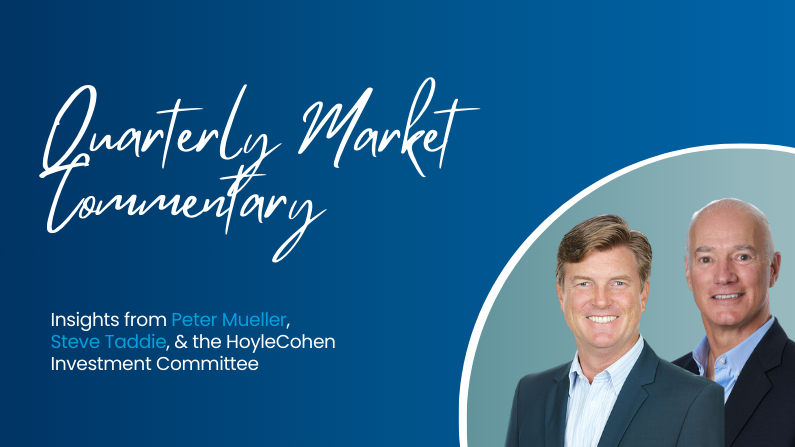HAPPY NEW YEAR!
By, Steve Taddie, Peter Mueller, & the HC Investment Committee
The fourth quarter started out with low expectations as rising long-term interest rates extended the late summer decline in the S&P 500, taking asset and portfolio values down. The stock and bond markets reached crescendo lows near the end of October as investor sentiment and confidence declined. With the release of positive third-quarter economic data and business activity reports coupled with better than feared corporate earnings results, markets began to turn. The resilience in the domestic jobs market led to a healthier consumer which fueled better than expected consumer spending and economic growth. Additionally, inflation data softened faster than expectations and neutral monetary policy guidance from the Federal Reserve led to a rapid change in investor confidence. As a result, both stock prices and long-term interest rates reversed direction, and we experienced one of the more powerful rallies in both the stock and bond markets than we have seen in recent years. In the bond market, after causing much pain for investors in the first 10 months of the year, the yield on the 10-year US Treasury ended the year roughly where it started at about 3.9%. In the stock market, after some volatility, the S&P 500 ended the year ahead by about 25%. Alternative and private investments kept their heads down, providing both stability and competitive returns, but did not keep up with the explosive turnaround in the public markets.
For those tuned in to our Economic & Market Commentaries and Mid-Quarter Updates, our more optimistic than consensus view on longer-term economic trends was evident. That view materialized slowly over the course of the year, but once the consensus moved in our direction, the impact was realized by the markets in short order as both the stock and bond markets rallied in the last two months of the year, taking the S&P 500 near all-time highs. In the end, 2023 turned out to be a good year for both stock and bond investors.
The economic stalwart throughout the year has been the US consumer, backed by a healthy jobs market, rising wages, and the benefit of the fixed-rate housing financing mechanism. Approximately 65% of households own a home, and Forbes magazine reports that 40% of those homeowners do not have a mortgage. For those that do have mortgages, about 95% have a fixed rate well under current lending rates. Therefore, the impact of higher mortgage interest rates and related housing inflation (30% of the Consumer Price Index is shelter costs) does not significantly affect more than 60% of the population. This combination improves the cash flow and boosts the confidence of the average consumer. With consumption making up about 70% of US economic activity, strong labor conditions and fixed-rate mortgages have been an important foundation of our economic resilience.
As we enter 2024, the US economy has thus far avoided the feared recession and a re-acceleration of inflation. The Federal Reserve has turned from hawkish to neutral and now sounds more dovish about the year to come, providing a good backdrop to start the year. Should productivity gains continue to improve, we should see a broader-based rise in corporate earnings expectations during 2024, despite slower overall economic growth. Increased earnings expectations and momentum should justify the valuation expansion large US companies experienced during this quarter.
Over the past year, stock market performance (as measured by the S&P 500) has primarily been driven by 10 companies. Those 10 companies make up over 30% of the S&P 500 (Apple and Microsoft combined accounting for almost 14% of the overall index), pushing most of the return in the index this year. However, the valuations of the other 490 stocks in the S&P 500 have not kept up with the top 10, and the same is true for US mid- and small-cap, international, and emerging market companies. Entering periods like this, the value of portfolio management rises, as finding great investments at attractive valuations can reduce risks and drive future returns.
Monetary and fiscal policy are huge drivers of our economy, and one needs to pay attention to not only policy action, but also associated “jawboning” or Fed speak as it can indicate how policy makers are leaning and give clues to future direction. At present, monetary policy looks tight, but is expected to loosen, which would be supportive of increased economic activity. The hecklers on either side of the inflation/growth debate have dwindled, as it looks like the Federal Reserve has played a good game to date, and the expected policy direction seems sound. Looking at the big picture for 2024, the consensus forecast for economic growth stands at less than 2%, and inflation at less than 2%. We think the consensus economic growth forecast may underestimate actual economic growth due to the underestimation of the strength of the US consumer.
All the best,

Stephen J. Taddie, CBE® CFM

Peter Mueller, MBA, CFP®
For a downloadable version of this quarterly commentary click here.
The information provided here is general in nature and is shared for information purposes only; nothing herein should be interpreted as investment or tax advice. Any and all tax laws and/or specific tax rates referenced are subject to change. It should not be assumed that future performance of any specific investment or investment strategy will be profitable. Always consult your CPA/tax advisor/attorney (or reach out to us;) to discuss your specific situation. All investments carry the risk of loss, including the permanent loss of principal. Past performance is no guarantee of future results.

